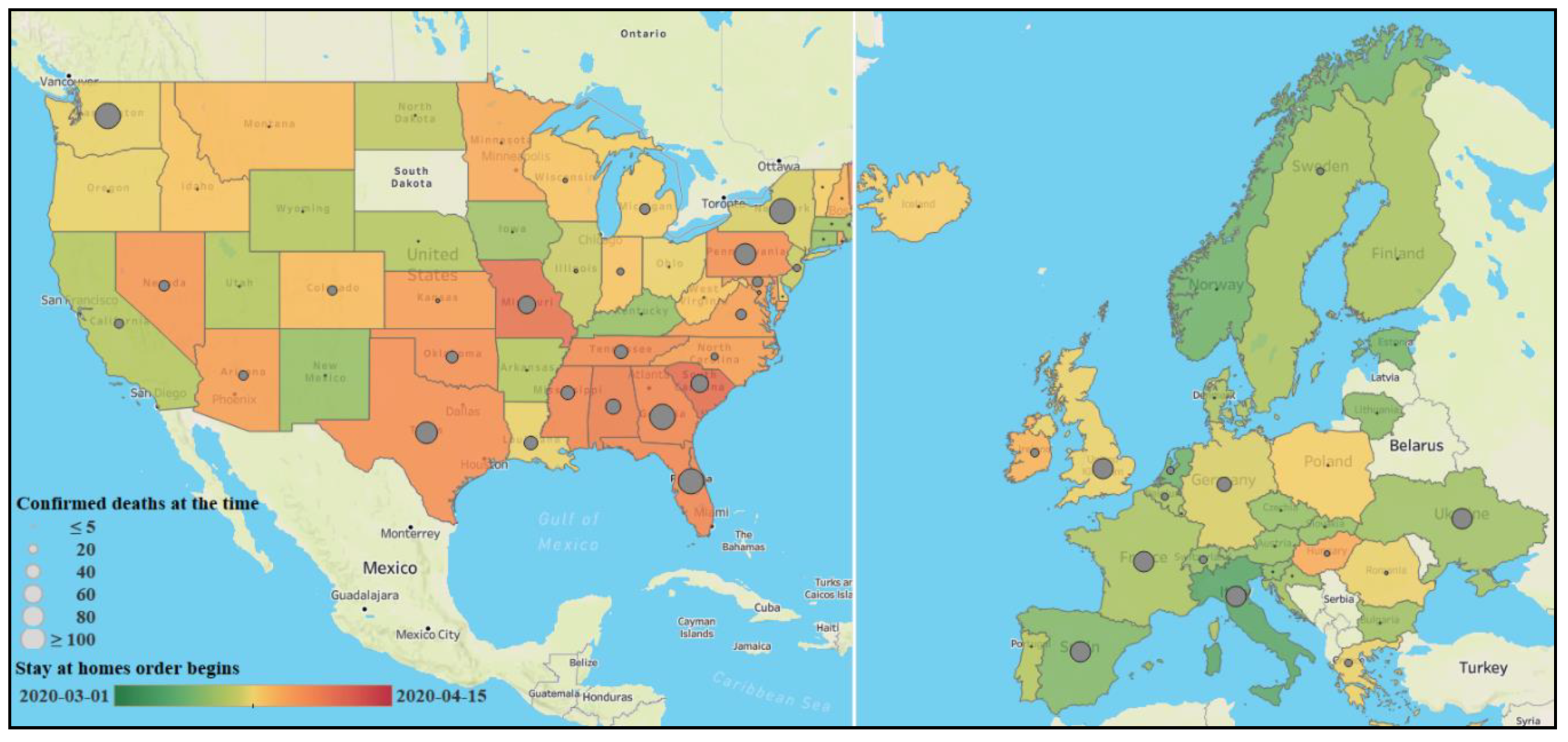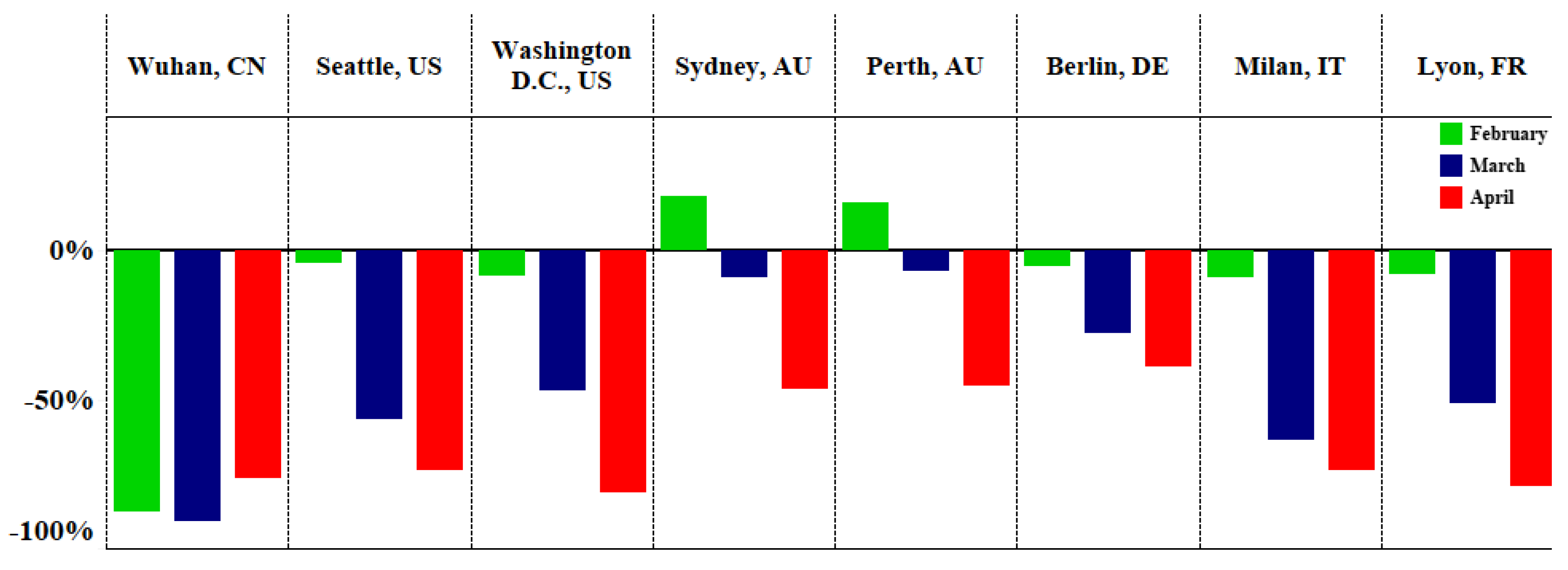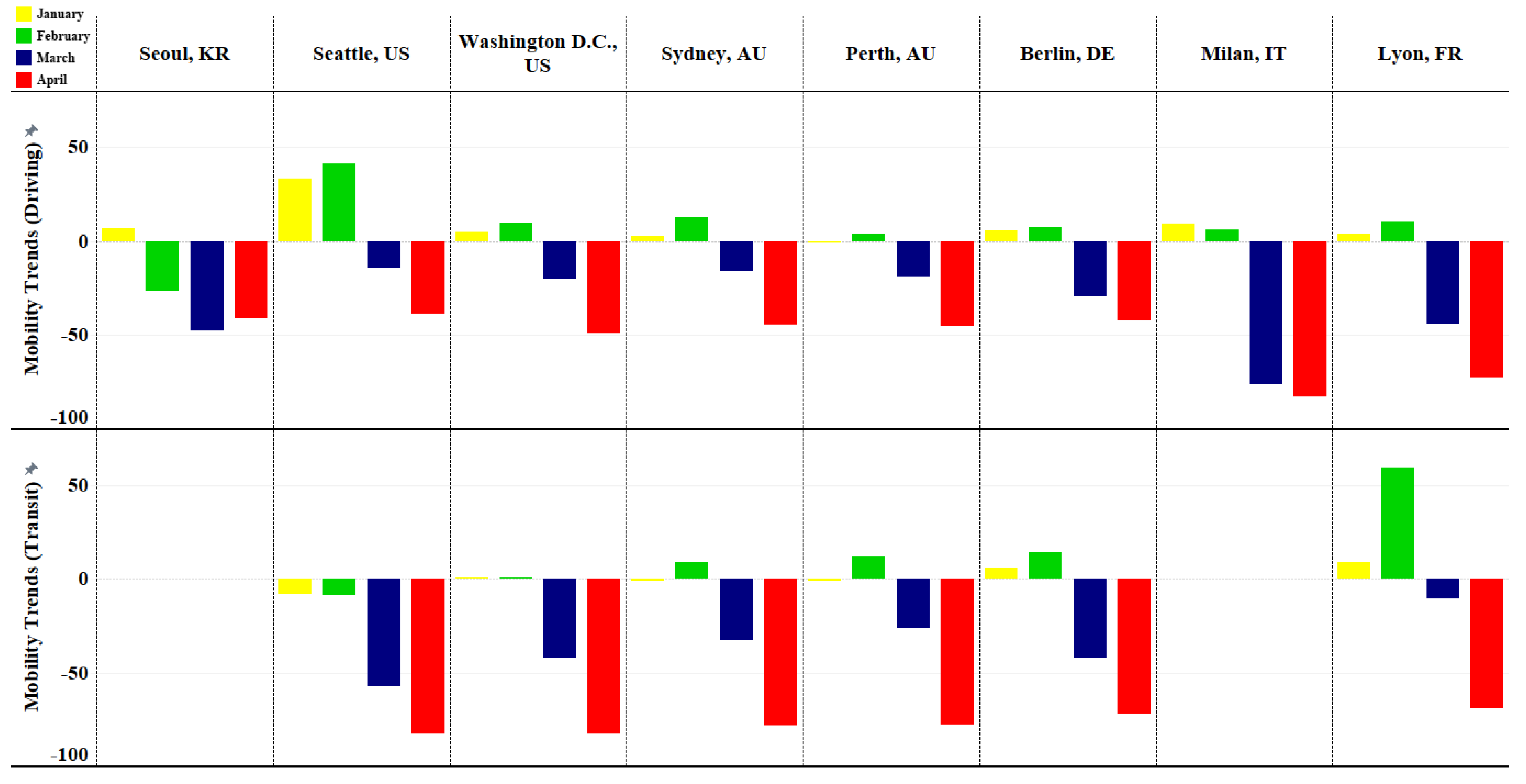COVID-19 and the Improvement of the Global Air Quality: The Bright Side of a Pandemic
Abstract
1. Introduction
2. Air Quality Indicators and Human Activities
3. Materials and Methods
4. Results
4.1. Congestion Levels and Mobility Trends
4.2. Air Quality Improvement
4.2.1. Nitrogen Dioxide (NO2)
4.2.2. Carbon Monoxide (CO)
4.2.3. Particle Matter (PM2.5)
4.2.4. Ozone (O3)
5. Discussion and Future Projections
Author Contributions
Funding
Conflicts of Interest
References
- NOAA. Greenhouse Gases. Available online: https://www.ncdc.noaa.gov/monitoring-references/faq/greenhouse-gases.php (accessed on 5 October 2020).
- Easterbrook, D.J. Greenhouse gases. Evidence-Based Climate Science; Elsevier: Amsterdam, The Netherlands, 2016; pp. 163–173. [Google Scholar]
- NASA GISS. Science Briefs—Greenhouse Gases: Refining the Role of Carbon Dioxide. Available online: https://www.giss.nasa.gov/research/briefs/ma_01/ (accessed on 5 October 2020).
- IEA. CO2 Emissions from Fuel Combustion 2018; International Energy Agency: Paris, France, 2018; p. 98. [Google Scholar]
- Lu, W.C. Greenhouse gas emissions, energy consumption and economic growth: A panel cointegration analysis for 16 Asian countries. Int. J. Environ. Res. Public Health 2017, 14, 1436. [Google Scholar] [CrossRef] [PubMed]
- Onafowora, O.A.; Owoye, O. Bounds testing approach to analysis of the environment Kuznets curve hypothesis. Energy Econ. 2014, 44, 47–62. [Google Scholar] [CrossRef]
- Richter, A.; Burrows, J.P.; Nüß, H.; Granier, C.; Niemeier, U. Increase in tropospheric nitrogen dioxide over China observed from space. Nature 2005, 437, 129–132. [Google Scholar] [CrossRef] [PubMed]
- Vrekoussis, M.; Richter, A.; Hilboll, A.; Burrows, J.P.; Gerasopoulos, E.; Lelieveld, J.; Barrie, L.; Zerefos, C.; Mihalopoulos, N. Economic crisis detected from space: Air quality observations over Athens/Greece. Geophys. Res. Lett. 2013, 40, 458–463. [Google Scholar] [CrossRef]
- Castellanos, P.; Boersma, K.F. Reductions in nitrogen oxides over Europe driven by environmental policy and economic recession. Sci. Rep. 2012, 2, 265. [Google Scholar] [CrossRef]
- Russell, A.R.; Valin, L.C.; Cohen, R.C. Trends in OMI NO 2 observations over the US: Effects of emission control technology and the economic recession. Atmos. Chem. Phys. Discuss. 2012, 12, 15419–15452. [Google Scholar] [CrossRef]
- Zhu, N.; Zhang, D.; Wang, W.; Li, X.; Yang, B.; Song, J.; Zhao, X.; Huang, B.; Shi, W.; Lu, R.; et al. A novel coronavirus from patients with pneumonia in China, 2019. N. Engl. J. Med. 2020, 382, 727–733. [Google Scholar] [CrossRef]
- World Health Organization (WHO). Coronavirus Disease (COVID-19) Weekly Epidemiological Update and Weekly Operational Update. Available online: https://www.who.int/emergencies/diseases/novel-coronavirus-2019/situation-reports (accessed on 5 October 2020).
- Institute for Health Metrics and Evaluation (I.H.M.E.). United States COVID-19 Hospital Needs and Death Projections; Institute for Health Metrics and Evaluation (I.H.M.E.); University of Washington: Seattle, WA, USA, 2020; Available online: https://covid19.healthdata.org/united-states-of-america (accessed on 5 October 2020).
- Wang, Q.; Su, M. A preliminary assessment of the impact of COVID-19 on environment–A case study of China. Sci. Total Environ. 2020, 728, 138915. [Google Scholar] [CrossRef]
- Muhammad, S.; Long, X.; Salman, M. COVID-19 pandemic and environmental pollution: A blessing in disguise? Sci. Total Environ. 2020, 728, 138820. [Google Scholar] [CrossRef]
- Xu, K.; Cui, K.; Young, L.H.; Hsieh, Y.K.; Wang, Y.F.; Zhang, J.; Wan, S. Impact of the COVID-19 event on air quality in Central China. Aerosol Air Qual. Res. 2020, 20, 915–929. [Google Scholar] [CrossRef]
- Zhu, Y.; Xie, J.; Huang, F.; Cao, L. Association between short-term exposure to air pollution and COVID-19 infection: Evidence from China. Sci. Total Environ. 2020, 727, 138704. [Google Scholar] [CrossRef] [PubMed]
- Sharma, S.; Zhang, M.; Gao, J.; Zhang, H.; Kota, S.H. Effect of restricted emissions during COVID-19 on air quality in India. Sci. Total Environ. 2020, 728, 138878. [Google Scholar] [CrossRef] [PubMed]
- Mahato, S.; Pal, S.; Ghosh, K.G. Effect of lockdown amid COVID-19 pandemic on air quality of the megacity Delhi, India. Sci. Total Environ. 2020, 730, 139086. [Google Scholar] [CrossRef] [PubMed]
- Tobías, A.; Carnerero, C.; Reche, C.; Massagué, J.; Via, M.; Minguillón, M.C.; Alastuey, A.; Querol, X. Changes in air quality during the lockdown in Barcelona (Spain) one month into the SARS-CoV-2 epidemic. Sci. Total Environ. 2020, 726, 138540. [Google Scholar] [CrossRef]
- Nakada, L.Y.; Urban, R.C. COVID-19 pandemic: Impacts on the air quality during the partial lockdown in São Paulo state, Brazil. Sci. Total Environ. 2020, 730, 139087. [Google Scholar] [CrossRef]
- Dantas, G.; Siciliano, B.; França, B.B.; da Silva, C.M.; Arbilla, G. The impact of COVID-19 partial lockdown on the air quality of the city of Rio de Janeiro, Brazil. Sci. Total Environ. 2020, 729, 139085. [Google Scholar] [CrossRef]
- Abdullah, S.; Mansor, A.A.; Napi, N.N.; Mansor, W.N.; Ahmed, A.N.; Ismail, M.; Ramly, Z.T. Air quality status during 2020 Malaysia Movement Control Order (MCO) due to 2019 novel coronavirus (2019-nCoV) pandemic. Sci. Total Environ. 2020, 729, 139022. [Google Scholar] [CrossRef]
- WHO. Ambient Air Pollution: Pollutants. Available online: https://www.who.int/airpollution/ambient/pollutants/en/ (accessed on 5 October 2020).
- EPA. Air Pollution: Current and Future Challenges. Available online: https://www.epa.gov/clean-air-act-overview/air-pollution-current-and-future-challenges (accessed on 5 October 2020).
- Ghorani-Azam, A.; Riahi-Zanjani, B.; Balali-Mood, M. Effects of air pollution on human health and practical measures for prevention in Iran. J. Res. Med Sci. Off. J. Isfahan Univ. Med Sci. 2016, 21, 65. [Google Scholar]
- Environmental Defense Fund. Available online: https://www.edf.org/health/health-impacts-air-pollution (accessed on 5 October 2020).
- EPA. Report on the Environment Air Pollution, Outdoor Air Quality. Available online: https://www.epa.gov/report-environment/outdoor-air-quality (accessed on 5 October 2020).
- EPA. Ground-Level Ozone Pollution. Available online: https://www.epa.gov/ground-level-ozone-pollution/ground-level-ozone-basics (accessed on 5 October 2020).
- WHO. WHO Air Quality Guidelines, Global Update, 2005: Report on a Working Group Meeting, Bonn, Germany, 18–20 October 2005; WHO Regional Office for Europe: Copenhagen, Denmark, 2005; Available online: https://www.euro.who.int/__data/assets/pdf_file/0008/147851/E87950.pdf (accessed on 5 October 2020).
- US EPA. National Ambient Air Quality Standards. Available online: https://www.epa.gov/criteria-air-pollutants/naaqs-table (accessed on 5 October 2020).
- European Commission in Europe. Air Quality Standards. Available online: https://ec.europa.eu/environment/air/quality/standards.htm (accessed on 5 October 2020).
- IQAir. World’s Most Polluted Cities 2019. Available online: https://www.iqair.com/us/world-most-polluted-cities (accessed on 5 October 2020).
- World Air Quality Index (WAQI). Available online: https://aqicn.org/ (accessed on 5 October 2020).
- TomTom Traffic Index. Available online: https://www.tomtom.com/en_gb/traffic-index/ (accessed on 5 October 2020).
- Apple. Mobility Trend Reports. 2020. Available online: https://www.apple.com/covid19/mobility/ (accessed on 5 October 2020).
- Tableau Public Version 2020.3 Software. Available online: https://public.tableau.com/en-us/s/ (accessed on 5 October 2020).
- Seinfeld, J.H.; Pandis, S.N. Atmospheric Chemistry and Physics: From Air Pollution to Climate Change; John Wiley & Sons: Hoboken, NJ, USA, 2016. [Google Scholar]
- Berman, J.D.; Ebisu, K. Changes in US air pollution during the COVID-19 pandemic. Sci. Total Environ. 2020, 739, 139864. [Google Scholar] [CrossRef]
- Karuppasamy, M.B.; Seshachalam, S.; Natesan, U.; Ayyamperumal, R.; Karuppannan, S.; Gopalakrishnan, G.; Nazir, N. Air pollution improvement and mortality rate during COVID-19 pandemic in India: Global intersectional study. Air Qual. Atmos. Health 2020, 13, 1–10. [Google Scholar] [CrossRef]
- Le, T.; Wang, Y.; Liu, L.; Yang, J.; Yung, Y.L.; Li, G.; Seinfeld, J.H. Unexpected air pollution with marked emission reductions during the COVID-19 outbreak in China. Science 2020, 369, 702–706. [Google Scholar] [CrossRef] [PubMed]
- Briz-Redón, Á.; Belenguer-Sapiña, C.; Serrano-Aroca, Á. Changes in air pollution during COVID-19 lockdown in Spain: A multi-city study. J. Environ. Sci. 2020, 101, 16–26. [Google Scholar] [CrossRef]
- Zangari, S.; Hill, D.T.; Charette, A.T.; Mirowsky, J.E. Air quality changes in New York City during the COVID-19 pandemic. Sci. Total Environ. 2020, 742, 140496. [Google Scholar] [CrossRef]
- Kwok, R.H.; Baker, K.R.; Napelenok, S.L.; Tonnesen, G.S. Photochemical grid model implementation and application of VOC, NOx, and O3 source apportionment. Geosci. Model Dev. 2015, 8, 99–114. [Google Scholar] [CrossRef]
- US EPA (US Environmental Protection Agency). Final Ozone NAAQS Regulatory Impact Analysis; EPA-452/R-08-003; US EPA, Office of Air Quality Planning and Standards: Durham, NC, USA, 2008.
- Beekmann, M.; Vautard, R. A modelling study of photochemical regimes over Europe: Robustness and variability. Atmos. Chem. Phys. 2010, 10, 10067. [Google Scholar] [CrossRef]
- Abu-Rayash, A.; Dincer, I. Analysis of mobility trends during the COVID-19 coronavirus pandemic: Exploring the impacts on global aviation and travel in selected cities. Energy Res. Soc. Sci. 2020, 68, 101693. [Google Scholar] [CrossRef]
- IEA. Global Energy Review 2020; International Energy Agency: Paris, France, 2020; Available online: https://www.iea.org/reports/global-energy-review-2020 (accessed on 5 October 2020).
- Blumberg, S. NASA Satellite Data Show 30 Percent Drop in Air Pollution over Northeast U.S. 2020. Available online: https://www.nasa.gov/feature/goddard/2020/drop-in-air-pollution-over-northeast (accessed on 5 November 2020).
- Rich, D.Q.; Kipen, H.M.; Huang, W.; Wang, G.; Wang, Y.; Zhu, P.; Ohman-Strickland, P.; Hu, M.; Philipp, C.; Diehl, S.R.; et al. Association between changes in air pollution levels during the Beijing Olympics and biomarkers of inflammation and thrombosis in healthy young adults. JAMA 2012, 307, 2068–2078. [Google Scholar] [CrossRef]
- Peel, J.L.; Klein, M.; Flanders, W.D.; Mulholland, J.A.; Tolbert, P.E. Impact of improved air quality during the 1996 Summer Olympic Games in Atlanta on multiple cardiovascular and respiratory outcomes. Res. Rep. Health Eff. Inst. 2010, 148, 3–23. [Google Scholar]
- Copernicus: Sentinel-5P (Precursor-Atmospheric Monitoring Mission). 2020. Available online: https://directory.eoportal.org/web/eoportal/satellite-missions/c-missions/copernicus-sentinel-5p (accessed on 5 November 2020).
- NASA. Earth observatory National Aeronautics and Space Administration, Airborne Nitrogen Dioxide Plummets Over China. Available online: https://earthobservatory.nasa.gov/images/146362/airborne-nitrogen-dioxide-plummets-over-china (accessed on 5 November 2020).
- Kerimray, A.; Baimatova, N.; Ibragimova, O.P.; Bukenov, B.; Kenessov, B.; Plotitsyn, P.; Karaca, F. Assessing air quality changes in large cities during COVID-19 lockdowns: The impacts of traffic-free urban conditions in Almaty, Kazakhstan. Sci. Total Environ. 2020, 4, 139179. [Google Scholar] [CrossRef]
- Collivignarelli, M.C.; Collivignarelli, C.; Miino, M.C.; Abbà, A.; Pedrazzani, R.; Bertanza, G. SARS-CoV-2 in sewer systems and connected facilities. Process Saf. Environ. Prot. 2020, 143, 196–203. [Google Scholar] [CrossRef]
- Sicard, P.; Paoletti, E.; Agathokleous, E.; Araminienė, V.; Proietti, C.; Coulibaly, F.; De Marco, A. Ozone weekend effect in cities: Deep insights for urban air pollution control. Environ. Res. 2020, 191, 110193. [Google Scholar] [CrossRef] [PubMed]







| Pollutant | Averaging Time | Unit | WHO | EPA NAAQS | EC |
|---|---|---|---|---|---|
| PM2.5 | Annual mean | µg/m3 | 10 | 12 | 25 |
| 24-h mean | µg/m3 | 25 | 35 | – | |
| PM2.5 | Annual mean | µg/m3 | 20 | 40 | |
| 24-h mean | µg/m3 | 50 | 150 | 50 (×35 *) | |
| NO2 | Annual mean | µg/m3 | 40 | 100 | 40 |
| 1-h mean | µg/m3 | 200 | 188 | 200 (×18 *) | |
| O3 | Daily 8-h maximum | µg/m3 | 100 | 138 | 120 ** |
| CO | 8-h mean | µg/m3 | 10.35 | 10 | |
| 1-h mean | µg/m3 | 40.25 |
Publisher’s Note: MDPI stays neutral with regard to jurisdictional claims in published maps and institutional affiliations. |
© 2020 by the authors. Licensee MDPI, Basel, Switzerland. This article is an open access article distributed under the terms and conditions of the Creative Commons Attribution (CC BY) license (http://creativecommons.org/licenses/by/4.0/).
Share and Cite
Habibi, H.; Awal, R.; Fares, A.; Ghahremannejad, M. COVID-19 and the Improvement of the Global Air Quality: The Bright Side of a Pandemic. Atmosphere 2020, 11, 1279. https://doi.org/10.3390/atmos11121279
Habibi H, Awal R, Fares A, Ghahremannejad M. COVID-19 and the Improvement of the Global Air Quality: The Bright Side of a Pandemic. Atmosphere. 2020; 11(12):1279. https://doi.org/10.3390/atmos11121279
Chicago/Turabian StyleHabibi, Hamideh, Ripendra Awal, Ali Fares, and Masoud Ghahremannejad. 2020. "COVID-19 and the Improvement of the Global Air Quality: The Bright Side of a Pandemic" Atmosphere 11, no. 12: 1279. https://doi.org/10.3390/atmos11121279
APA StyleHabibi, H., Awal, R., Fares, A., & Ghahremannejad, M. (2020). COVID-19 and the Improvement of the Global Air Quality: The Bright Side of a Pandemic. Atmosphere, 11(12), 1279. https://doi.org/10.3390/atmos11121279






